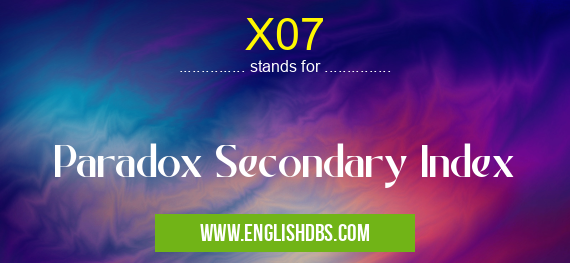What does X07 mean in FILE EXTENSIONS
X07 is an acronym in computing which stands for Paradox Secondary Index. A secondary index, also known as a non-clustered index, is a data structure used in databases and computers to quickly locate records without having to search through an entire table. It uses an alternate set of columns, separate from the primary key columns, that act as a sort of shortcut when searching through a database or other type of document. X07 is a specific type of secondary index created by Paradox, a relational database management system developed by Corel Corporation for Windows platforms.

X07 meaning in File Extensions in Computing
X07 mostly used in an acronym File Extensions in Category Computing that means Paradox Secondary Index
Shorthand: X07,
Full Form: Paradox Secondary Index
For more information of "Paradox Secondary Index", see the section below.
Essential Questions and Answers on Paradox Secondary Index in "COMPUTING»FILEEXT"
What is Paradox Secondary Index?
Paradox Secondary Index is an indexing strategy used to optimize querying of a Paradox database. It works by organizing the data into an easily searchable structure that allows for faster query times and more efficient storage. The secondary indexes can be used both for simple queries and complex joins, making them invaluable for large datasets.
What type of data can be indexed with the Paradox Secondary Index?
The Paradox Secondary Index can be used to index any type of data, including text, numerical values, dates, and objects. It is also capable of supporting multiple fields in an index if required.
How does the Paradox Secondary Index work?
The Paradox Secondary Index stores the data in a special structure which is optimized for fast access and retrieval. This structure enables quick searching and sorting so that queries can be processed quickly without having to scan all records in the database.
Are there any limitations on what types of queries can be run using a Paradox Secondary Index?
No, all types of queries are supported with the use of the secondary index. Complex joins, aggregations, filtering and sorting operations are all able to take advantage of its advantages compared to traditional table scans.
Is there any additional setup needed when creating a secondary index in Paradox?
Yes, some extra configuration is required when creating a new secondary index in order to ensure optimal performance when querying it. These include setting up the field ordering and establishing any necessary filters or predicates which will further restrict what records will be included in the index.
Does updating data affect my existing Paradox Secondary Indexes?
Generally yes - when data is added or removed from an indexed table then this needs to be reflected in the related secondary indexes too. This usually involves rebuilding affected indexes which may require some downtime or performance impact during this process depending on your specific usage patterns and dataset size.
Is it possible to add multiple fields into one secondary index in Paradox?
Yes - multiple fields can be added into one single secondary index if necessary by configuring it accordingly during creation time with orders determined by their relevance for queries expected against that particular table/index combination.
Can I customize my indexes in terms of storage parameters such as block size etc.?
Yes - you have flexibility over several storage related parameters including block size (for example), allowing you to fine-tune these aspects depending on your specific needs.
Does using a paradox secondary Index guarantee more efficient querying?
Generally yes – By organizing data into an easily searchable format it makes access times quicker compared to doing full scanning across large tables each time you query them.
Are there any third party tools available which provide support for using paradox secondary indices?
Yes – There are many different vendors offering tools that allow easy setup, maintenance and optimization of paradox databases leveraging their associated indices.
Final Words:
In short, the Paradox Secondary Index (X07) is very useful for optimizing data searches within databases and other documents requiring fast retrieval times and accurate results. It does this by creating separate indexes on individual fields or columns, which are then stored separately from the main data file allowing quick access when needed. Furthermore, it helps conserve storage space by not needing to generate many individual indexes each time a change needs to be made - such as adding an additional column - thus making administration easier and less time consuming.
